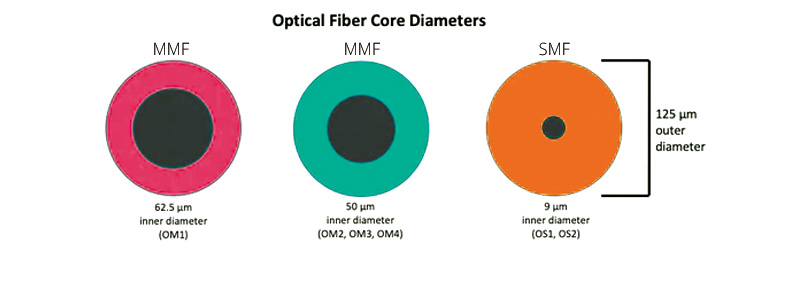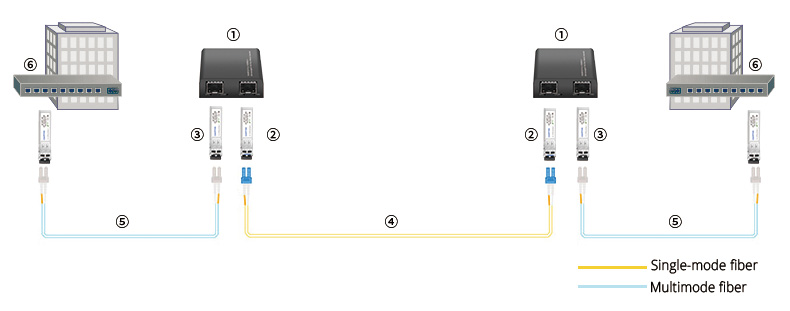How to Convert Multimode to Single-mode Fiber or vice versa?
A lightwave with a certain frequency, polarization state, and transmission direction is called a lightwave transmission mode. Multimode fiber (MMF) and single-mode fiber (SMF) are two fiber optic cable types classified by transmission mode. One distinction in function is the transmission distance. The local area network (LAN) often deploys MMFs and MMF equipment for in-building short-range connections. Therefore, the link between buildings from the LAN to the wide-area network (WAN) needs to use single-mode fiber to extend the transmission distance. This article introduces the fiber mode conversion background and three conversion methods between single-mode and multimode.
Knowledge Basis of Multimode vs Single-mode Fiber
One can distinguish SMF from MMF by the outer jacket color — single-mode fiber has a yellow cable jacket while fibers with orange, aqua blue, rose red, or green cable jackets are multimode fibers.
Light travels straight through the core without any reflection occurring from the fiber core-cladding wall in single-mode fiber. In multimode fiber, a light pulse separates into several beams and reflects constantly along the inner wall, which brings lots of dispersion and signal loss.

Fig 1: Single-mode vs multimode fiber transmission mode
Accordingly, multimode fiber has transmission restrictions. The max transmission capacity of MMF is about 300m to 400m. However, single-mode fiber without power loss can deliver the light for much longer, 10km, 20km, 40km, 80km, and even farther.
Another difference between the two is the core diameter. Single-mode fiber core has a very narrow diameter, typically 5µm, 7µm, and 9µm. Multimode fiber core diameter is several times of the single-mode fiber, 62.5µm or 50µm are common.

Fig 2: Single-mode vs multimode fiber core diameter
When users want to use single-mode with multimode fiber together, the idea first comes to mind is to connect them directly. Due to the SMF vs MMF significant difference in fiber core diameter size, passively splicing or coupling multimode to single-mode fiber will cause link failure. The fiber mode conversion is to find ways out of the issue.
What Drives Multimode to Single-mode Conversion Demand or vice versa?
So what's the cause of mix-using multimode and single-mode fiber? As we see, the optics applied in point-to-point interconnection are symmetrical. For instance, end A with a 10G SFP+ port houses a 10GBASE-SR SFP+ module. To realize the short-range direct connection to the end B switch with the same port, the same 10GBASE-SR SFP+ module should be plugged into the end B switch port. Then use a multimode fiber to connect the two ends. This is the most ideal and simple application scenario.
What if end B is located in another building, dozens of kilometers far away from end A? Or end B equipment is single-mode or must use a single-mode fiber connection? In the former case, you need to use single-mode fiber because the multimode fiber cannot reach that far. The problem is how to realize SMF connects to the end equipment multimode modules. For the latter, the problem is how to achieve the connection between one end multimode and the other end single mode.
In different cabling environments, optical fiber communication may require multimode to single-mode conversion or single-mode to multimode conversion. But the most typical application is the conversion from multimode to single-mode to boost the network transmission distance.
Top 3 Solutions to Converter Multimode to Single-Mode Fiber or vice versa
Next, I will introduce three fiber mode conversion methods, what they have in common is relying on single-to-multimode conversion products.
Solution 1: Using Fiber to Fiber Media Converters for Multimode to Single-Mode Conversion
Fiber to Fiber media converter provides multiple conversion functions, ie. multimode to single-mode conversion, duplex to simplex conversion, and standard to WDM wavelength conversion. To understand how fiber media converter transfer multimode to single-mode, take the multimode to single-mode fiber converter by QSFPTEK as an example. The product has two SFP/SFP+ slots, which can accommodate two SFP/SFP+ modules. To converter MMF to SMF, plug one of the slots with a 10GBASE-SR SFP+ transceiver for multimode fiber connection and the other slot with a 10GBASE-LR SFP+ transceiver for single-mode fiber link. Thus a local MMF link within 400m can boost up to at least 10km and up to 140km by matching difference optics.
In the application scenario below, two Ethernet switches located in two buildings are needed to be connected. Both the switches are equipped with multimode fiber modules, but the distance between the buildings is about 6km. We deploy a pair of 10G fiber-to-fiber media converters and two 10G-SR SFP+s to connect the Ethernet switches over OM3 MMFs. Then link the other media converter port at both ends with 10G-LR SFPs over an OS2 SMF.

Fig 3: Converter Multimode to single-mode with multimode to single-mode media converter
Solution 2: Using WDM Transponder for Multimode to Single-Mode Conversion
WDM transponder is also known as optical to electrical to optical (OEO). The WDM systems see wide adoption of WDM transponder (OEO) for converting legacy wavelength to CWDM or DWDM wavelength. Besides, OEO also functions for MMF-to-SMF conversion, which is achieved by converting the 850nm MMF to 1310nm SMF.
In the example below, the two ports of this WDM transponder have a single-mode SFP and a multi-mode SFP respectively. As in the previous solution, use an OM3 MMF to connect the multi-mode port of the OEO and the multi-mode port of the switch. Then link the WDM transponder SMF SFP ports via a single-mode OS2 fiber to extend reach between buildings.

Fig 4: Converter Multimode to single-mode with WDM transponder
Solution 3: Using Mode Conditioning Patch Cables For Single-Mode to Multimode Conversion
In structure, a mode conditioning patch (MCP) cable is a duplex fiber patch cable consisting of two strands of fibers. One end of one of the fibers terminates a single-mode connector and a short piece of SMF. The other three terminals are multimode connectors and MMFs. The only SMF leg in yellow of the MCP cable is for connecting the 1000BASE-LX and other capable modules in transmitting equipment. The requirement for MCP strictly limits the module types. For gigabit Ethernet, the requirement for MCP is specified only for 1000BASE-LX/LH 1G SFPs in the 1310 nm wavelength window. For 10 gigabit Ethernet, it is stipulated only for 10GBASE-LX4 and 10GBASE-LRM optics in the 1310 nm wavelength window. The MMF leg in orange is to link the receiving side. One thing to note is MCP fiber can only transfer single-mode to multimode, not vice versa.

Fig 5: Converter single-mode to Multimode with mode-conditioning patch cable
QSFPTEK Fiber Mode Conversion Solutions
QSFPTEK fiber media converter provides MMF to SMF conversion and dual fiber to single fiber conversion. The network connectivity solutions are shown in the figures below.
In the following cases, two fiber switches are placed in two buildings. The in-building network is based on cost-effective multimode fibers and multimode SFPs. The distance between the buildings is 10km or even longer. The problem here is to achieve the switch-to-switch connection between the two buildings.
MMF to SMF Conversion
This solution deploys fiber to fiber media converters to convert multimode to single-mode. Then insert 10GBASE-LR/ER/ZR SFP+ modules based on the link range and single-mode fiber for a long-range link.

Fig 6: QSFPTEK multimode to single-mode fiber converter solution
Solution Product Portfolio:
Dual Fiber to Single Fiber Conversion
Using a pair of fiber media converters to convert the dual fiber to a single fiber. Then plug BIDi SFP+ modules and simplex fiber for a long-range link.

Fig 7: QSFPTEK duplex to simplex fiber converter solution
Solution Product Portfolio:
Conclusion
In summary, single-mode and multimode fiber conversion is required for the following cases:
• The current MMF network cannot fit the long-distance transmission needs
• SMF connectivity is a must to the equipment based on multimode connection
Multimode to single-mode media converter and WDM transponder are two solutions to achieve MMF-to-SMF conversion or SMF-to-MMF conversion. For non-WDM networks, choosing a fiber media converter is more cost-effective since a WDM transponder is expensive. Mode conditioning fiber patch cables are for SMF-to-MMF conversion only. The MCP price in the market is also affordable.
If you're looking for fiber mode conversion solutions, no matter multimode to single-mode or single-mode to multimode, QSFPTEK is glad to help. Our experts have dozens of years of R&D experience. For product quotation, please live chat with our sales or email via [email protected].











